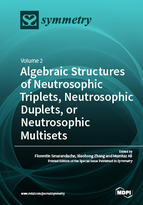Algebraic Structures of Neutrosophic Triplets, Neutrosophic Duplets, or Neutrosophic Multisets
A special issue of Symmetry (ISSN 2073-8994). This special issue belongs to the section "Computer".
Deadline for manuscript submissions: closed (31 October 2018) | Viewed by 202137
Special Issue Editors
Interests: neutrosophic probability; neutrosophic statistics; neutrosophic algebraic structures; plithogenic set; unmatter; superluminal physics; paradoxism; quantum paradoxes
Special Issues, Collections and Topics in MDPI journals
2. Department of Mathematics, Shanghai Maritime University, Shanghai, China
Interests: non-classical logic algebras; fuzzy sets; rough sets; neutrosophic sets; neutrosophic triplet structures; neutrosophic duplet structures
Special Issues, Collections and Topics in MDPI journals
Interests: agricultural crop modelling; atmospheric and hydrology; renewable and sustainable energy resources
Special Issues, Collections and Topics in MDPI journals
Special Issue Information
Dear Colleagues,
Neutrosophy (1995) is a new branch of philosophy that studies triads of the form (<A>, <neutA>, <antiA>), where <A> is an entity {i.e. element, concept, idea, theory, logical proposition, etc.}, <antiA> is the opposite of <A>, while <neutA> is the neutral (or indeterminate) between them, i.e., neither <A> nor <antiA>.
See http://fs.gallup.unm.edu/neutrosophy.htm
Based on neutrosophy, the neutrosophic triplets were founded, which have a similar form
(x, neut(x), anti(x), that satisfy some axioms, for each element x in a given set.
See in the three links below more information.
This special session invites original research papers that report on state-of-the-art and recent advancements of neutrosophic triplets, neutrosophic duplets, neutrosophic multisets and their algebraic structures – that have been defined recently in 2016 but have gained interest from world researchers, and several papers have been published in first rank international journals.
Connections between classical algebraic structures and neutrosophic triplet / duplet / multiset structures are also interesting. For more information see the University of New Mexico websites:
- Neutrosophic Triplet Structures
http://fs.gallup.unm.edu/NeutrosophicTriplets.htm
- Neutrosophic Duplet Structures
http://fs.gallup.unm.edu/NeutrosophicDuplets.htm
- Neutrosophic Multiset Structures
http://fs.gallup.unm.edu/NeutrosophicMultisets.htm
Prof. Dr. Florentin Smarandache
Prof. Dr. Xiaohong Zhang
Dr. Mumtaz Ali
Guest Editors
Manuscript Submission Information
Manuscripts should be submitted online at www.mdpi.com by registering and logging in to this website. Once you are registered, click here to go to the submission form. Manuscripts can be submitted until the deadline. All submissions that pass pre-check are peer-reviewed. Accepted papers will be published continuously in the journal (as soon as accepted) and will be listed together on the special issue website. Research articles, review articles as well as short communications are invited. For planned papers, a title and short abstract (about 100 words) can be sent to the Editorial Office for announcement on this website.
Submitted manuscripts should not have been published previously, nor be under consideration for publication elsewhere (except conference proceedings papers). All manuscripts are thoroughly refereed through a single-blind peer-review process. A guide for authors and other relevant information for submission of manuscripts is available on the Instructions for Authors page. Symmetry is an international peer-reviewed open access monthly journal published by MDPI.
Please visit the Instructions for Authors page before submitting a manuscript. The Article Processing Charge (APC) for publication in this open access journal is 2400 CHF (Swiss Francs). Submitted papers should be well formatted and use good English. Authors may use MDPI's English editing service prior to publication or during author revisions.
Keywords
- Neutrosophic Triplet Structures, http://fs.gallup.unm.edu/NeutrosophicTriplets.htm
- Neutrosophic Duplet Structures, http://fs.gallup.unm.edu/NeutrosophicDuplets.htm
- Neutrosophic Multiset Structures, http://fs.gallup.unm.edu/NeutrosophicMultisets.htm
- Applications of Neutrosophic Triplet Structures
- Applications of Neutrosophic Duplet Structures
- Applications of Neutrosophic Multiset Structures
- Neutrosophic sets
- Neutrosophic logic







